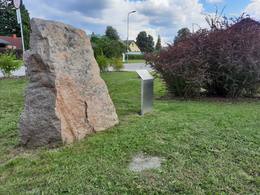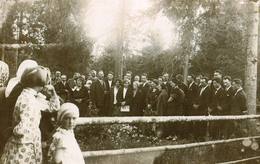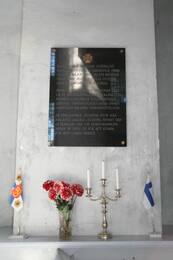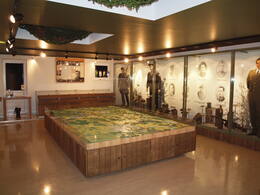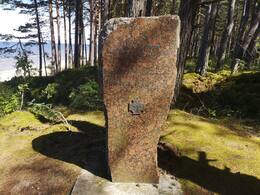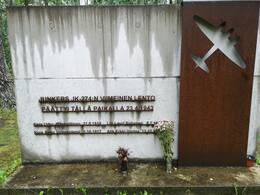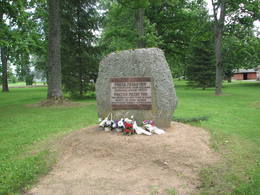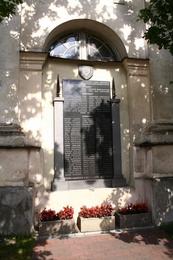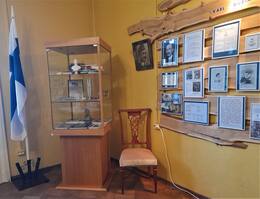Somu brīvprātīgo pulks “Ziemeļu zēni” (“Pohjan Pojat”)
I Neatkarības kari
“Ziemeļu zēni” (somu: Pohjan Pojat, igauņu: Põhja Pojad) bija Somijas brīvprātīgo pulks Latvijas un Igaunijas brīvības cīņu laikā no 1919. gada janvāra līdz aprīlim. Virspavēlnieks bija somu ģenerālis Martins Vecers (Martin Wetzer, 1868-1954), kurš vienlaicīgi bija arī Igaunijas Dienvidu frontes komandieris, savukārt pulka komandieris bija igauņu izcelsmes pulkvedis Hanss Kalms (Hans Kalm, 1889-1981). Liela daļa karavīru bija somu jēgeri, kas jau pirms tam bija piedalījušies Pirmā pasaules kara kaujās Zemgalē. Kopumā karadarbībā no janvāra līdz martam bija piedalījušies ap 3000—4000 somu brīvprātīgo karavīru.
Pulkam lieli nopelni kaujā pie Paju (igauņu: Paju lahing ) un Valkas atbrīvošanā no lieliniekiem 1919. gada 1. februārī. “Ziemeļu zēni” izcēlās arī cīņās par Alūksnes un Bejas atbrīvošanu no sarkanarmiešiem, kur krituši daudzi somu karavīri.
Pēc Latvijas Neatkarības kara četrpadsmit pulka karavīri, tostarp ģenerālis M. Vecers un pulkvedis H. Kalms, apbalvoti ar Lāčplēša Kara ordeni.
Bejas kapos apbedīti astoņi (arī septiņi? vai deviņi?) 1919. gada 22. februārī Bejas kaujā kritušie somu karavīri. 1989. gada 2. februārī kapos uzlikts balts koka krusts un koka sētiņa, bet 2000. gada 7. maijā Bejas kapos atklāja piemiņas akmeni ar uzrakstu "Šeit atdusas somu brīvprātīgo pulka Ziemeļu zēni karavīri, kuri krituši Bejas kaujā 1919. gadā."
1999. gada 17. oktobrī pie Jaunalūksnes pagasta novadpētniecības centra atklāja somu karavīriem veltītu piemiņas plāksni.
2019. gada februārī, atzīmējot 100. gadskārtu, kopš kaujas par Alūksni, pie dzelzceļa stacijas Alūksnē uzstādīja īpašu laukakmeni no Salpa līnijas (somu: Salpalinja) , kas sargāja Somijas austrumu robežu ar Krieviju.
Papildus izziņas avoti
Juris Ciganovs. Somu “Ziemeļu zēnu” cīņas Latvijā. SARGS.LV, 10.01.2015.: https://www.sargs.lv/lv/starpkaru-periods/2015-01-10/somu-ziemelu-zenu-cinas-latvija#lastcomment
Somu karavīru Brāļu kapi Bejā: https://timenote.info/lv/Somu-karaviru-Bralu-kapi-Beja
Lāčplēša Kara Ordeņa kavalieri: Biogrāfiska vārdnīca. Rīga: Jāņa Sēta, 1995.
Saistītās laikalīnijas
Saistītie objekti
Piemiņas akmens Somu brīvprātīgo pulkam “Ziemeļu zēni”
Atrodas Alūksnē, Jāņkalna ielā 52, pie Alūksnes šaursliežu dzelzceļa stacijas.
2019. gada 23. februārī, atzīmējot Latvijas Neatkarības kara simtgadi, pēc Neatkarības cīņu tradīciju apvienības (Somija) iniciatīvas, godinot par Latvijas neatkarību kritušos somu brīvprātīgos, izveidota īpaša piemiņas vieta, kurā par vēsturiskajiem notikumiem liecina īpašs laukakmens un informatīva plāksne. Piemiņu glabājošais akmens uz Alūksni atceļojis no Somijas - Salpa līnijas, kas būvēta 1940.-1944. gadā, lai aizsargātu Somijas Austrumu robežu. 1200 km garā Salpa līnija ir viena no ievērojamākajām neatkarīgās Somijas aizsardzības līnijām, kā arī viena no stiprākajām un labāk saglabātajām šāda veida aizsardzības būvēm pēc Otrā pasaules kara Eiropā.
Uz Alūksni atvestais akmens simbolizē divu tautu - somu un latviešu - cīņu par savu neatkarību. Somu brīvprātīgo pulks “Ziemeļu zēni” devās palīgā latviešiem sargāt jaunās Latvijas valsts brīvību. 1919. gada 21. februārī "Ziemeļu zēni" piedalījās sīvās cīņās Alūksnes (Marienburgas) apkārtnē. Pēc piecu stundu ilgas kaujas pie Alūksnes dzelzceļa stacijas somi ieņēma Alūksni. Šajā cīņā dzīvību zaudēja 23 somu brīvprātīgie un daudzi tika ievainoti.
Piemiņas plāksne somu jēgeriem Liepājas Sv.Trīsvienības katedrālē
Liepājas Sv.Trīsvienības katedrālē, Lielā ielā 9, atrodas somu jēgeriem veltīta piemiņas plāksne.
Somu jēgeri bija no Somijas izbraukušajiem brīvprātīgajiem izveidota Vācijas impērijas karaspēka vienība, kas ar nosaukumu 27. Karaliskais Prūsijas jēgeru batajons 1916. -1917. gadā piedalījās Pirmā pasaules kara kaujās Austrumu frontē Latvijas teritorijā.
Pirmā pasaules kara laikā Somijas lielkņaziste atradās Krievijas impērijas sastāvā un daudzi somi vēlējās Vācijas uzvaru karā, lai veicinātu neatkarīgas valsts izveidi. 1914. gada 20. novembrī Helsinkos dibināja Somijas neatkarības kustību, kas plānoja veidot arī neatkarīgās valsts bruņotos spēkus. Kad 1915. gada janvārī Vācijas valdība apstiprināja gatavību apmācīt somus, sākās brīvprātīgo vērvēšana un līdz 1916. gada pavasarim Vācijā atradās gandrīz 2000 karavīru, kurus nosauca par 27. Karalisko Prūsijas jēgeru bataljonu.
No 1916. gada jūnija bataljons atradās Rīgas frontē, kad līdz 1917. gada martā to pārvietoja uz Liepāju. Pēc Februāra revolūcijas sākās Krievijas impērijas sabrukšana un 1917. gada 6. decembrī Somijas parlaments pasludināja valsts neatkarību.
1918. gada 13. februārī bataljons zvērēja uzticību Somijai Liepājas Svētās Trīsvienības baznīcā. 1918. gada 15. februārī bataljons ar kuģiem devās no Liepājas ostas, lai atgrieztos dzimtenē Vasas ostā un piedalītos Somijas pilsoņu karā pret sarkanajiem, kas 1918. gada 27. janvārī bija veikuši valsts apvērsumu. Labi apmācītie un kaujas pieredzi ieguvušie jēgeri veidoja Somijas valsts armijas kodolu un liela daļa kļuva komandieriem Otrā pasaules kara laikā.
Svētās Trīsvienības baznīcā iesvētītais bataljona karogs kļuva par pirmo neatkarīgās Somijas karogu.
“Somu zēnu” muzejistaba
Muzejistaba atrodas Sādjerves dabas centrā Eksi pagastā.
To atklāja 2002. gadā ar “Somu zēnu” piemiņas biedrības, Tartu pašvaldības un Somijas valsts rīkojumu un atbalstu.
Ekspozīcija sniedz ieskatu Somijā un Igaunijā notikušajās Otrā pasaules kara kaujās, kurās piedalījās tā sauktie “Somu zēni”. Šeit var aplūkot Jegevas un Tartu apriņķī notikušo kauju modeļus, kā arī Somu zēnu mundierus, aprīkojumu, bruņojumu, militāros apbalvojumus, personīgās mantas un fotogrāfijas. Apmeklētājiem ir atvērts arī bunkurs.
Piemiņas zīme somu jēgeriem Smārdes kaujā
Atrodas Engures novadā, autoceļa A10 malā pie Smārdes kroga.
Piemiņas zīme uzstādīta vietā, kur laukā, iepretim Smārdes krogam, 1. pasaules kara laikā 1916. gadā notika Smārdes kauja. Kaujās Vācijas armijas sastāvā piedalījās somu jēgeru inženieru rota (~200 vīru). ”Smārdes diena” ir kļuvusi par Somijas armijas militāro inženieru oficiālo svētku dienu, kas tiek atzīmēta joprojām.
Somu jēgeri bija Vācijas armijas vienība, kas izveidota 1. pasaules karā. Tā sastāvēja galvenokārt no Krievijas impērijas, Somijas teritorijas izbraukušiem nacionāli noskaņotiem somu brīvprātīgajiem. Smārdes kauja bija viena no somu jēgeru nozīmīgākajām uzbrukuma kaujām, kur tika izmantota tam laikam jauna taktika.
Mēnesi pēc šī notikuma, Krievijas armija uzbruka Vācijas armijai pie Smārdes. Latviešu kaujas vienības veica Smārdes apkārtnes izlūkošanu, pāri purvam izbūvēja apgādes ceļu “Latviešu ceļš” un piedalījās cīņās. Kaujās krita ap 300 latviešu cīnītāju. Līdzīgi kā somu jēgeri Vācijas armijā, tā latviešu strēlnieki Krievijas armijā bija savu nacionālo valstu un armiju pamatlicēji.
Piemiņas vieta somu lidotājiem Saulkrastos
Atrodas autoceļa Lilaste-Saulkrasti mala, līdzās DUS "Viada".
Piemiņas vieta izveidota 2013. gadā vietā, kur 1943. gadā avarēja Somijas gaisa spēku lidmašīna. Katastrofā gāja bojā četri Somijas armijas karavīri, kuri veica pārlidojumu no Vācijas uz Somiju. Pieminekļa uzstādīšana, dizains un izgatavošana pilnībā bija Somijas pārstāvju iniciatīva. Uzstādīt piemiņas zīmes lidmašīnu krišanas vietās ir somu kara lidotāju tradīcija.
1943. gadā Somija no Vācijas iegādājās 24 modernus “Junker” firmas bumbvedējus. Tie bija paredzēti, lai papildinātu Somijas armijas gaisa spēkus ar modernām lidmašīnām. Rūpnīca lidmašīnas nodeva 1943. gadā un pēc pilotu apmācības, tās nogādāja Somijā. Vienas lidmašīnas lidojums beidzās traģiski. Tehnisku defektu dēļ lidotāji bija spiesti meklēt vietu, kur veikt avārijas nosēšanos. Lidmašīna zaudēja augstumu, līdz aizķēra kokus, nogāzās mežā un aizdegās. Somu lidotājus apglabāja Vācijas armijas kapsētā Rīgā laikā, kad Latvija bija Vācijas okupēta. Vēlāk viņus pārapbedīja dzimtenē.
Interesanti, ka arī Somijā 1938. gadā ir avarējusi Latvijā ražota viena no tā laika modernākajām lidmašīnām. To pilotēja Latvijas un Somijas armijas piloti - K. Lešinskis un F. Kuopameki.
Piemiņas akmens Somu brīvprātīgo pulkam “Ziemeļu zēni”
Atrodas Alūksnē, Jāņkalna ielā 52, pie Alūksnes šaursliežu dzelzceļa stacijas.
2019. gada 23. februārī, atzīmējot Latvijas Neatkarības kara simtgadi, pēc Neatkarības cīņu tradīciju apvienības (Somija) iniciatīvas, godinot par Latvijas neatkarību kritušos somu brīvprātīgos, izveidota īpaša piemiņas vieta, kurā par vēsturiskajiem notikumiem liecina īpašs laukakmens un informatīva plāksne. Piemiņu glabājošais akmens uz Alūksni atceļojis no Somijas - Salpa līnijas, kas būvēta 1940.-1944. gadā, lai aizsargātu Somijas Austrumu robežu. 1200 km garā Salpa līnija ir viena no ievērojamākajām neatkarīgās Somijas aizsardzības līnijām, kā arī viena no stiprākajām un labāk saglabātajām šāda veida aizsardzības būvēm pēc Otrā pasaules kara Eiropā.
Uz Alūksni atvestais akmens simbolizē divu tautu - somu un latviešu - cīņu par savu neatkarību. Somu brīvprātīgo pulks “Ziemeļu zēni” devās palīgā latviešiem sargāt jaunās Latvijas valsts brīvību. 1919. gada 21. februārī "Ziemeļu zēni" piedalījās sīvās cīņās Alūksnes (Marienburgas) apkārtnē. Pēc piecu stundu ilgas kaujas pie Alūksnes dzelzceļa stacijas somi ieņēma Alūksni. Šajā cīņā dzīvību zaudēja 23 somu brīvprātīgie un daudzi tika ievainoti.
Ziemeļu dēliem veltīts piemineklis
Šis piemineklis ir veltīts somu karavīriem un Ziemeļu dēlu pulka virsniekiem, kuri cīnījās Padžu kaujā. Piemineklis, ko rotā brūna granīta plāksne ar uzrakstu "Cēls darbs mūžīgi spīdēs cauri laiku plūdumam" igauņu un somu valodā, atrodas Padžu muižas parkā netālu no lielākā Padžu kaujas pieminekļa. Somijas valdība palīdzēja organizēt aptuveni 2300 somu brīvprātīgo izvietošanu valstī. Šim nolūkam viņiem bija jāatstāj dienests Somijas aizsardzības spēkos. Viņu ierašanās 1919. gada janvārī bija nozīmīgs pagrieziena punkts Neatkarības karā.
Piemiņas plāksne Ziemeļu dēliem
1934. gadā Valgas Svētā Jāņa baznīcas sienā tika uzstādīta melna granīta piemiņas plāksne ar gandrīz 200 vārdiem, pieminot somu brīvprātīgos, kuri krita Paju kaujā Neatkarības karā. To 1934. gadā atklāja toreizējais valsts vadītājs Konstantīns Petss. Uz vairoga virs akmens ir attēlots Ziemeļu dēlu pulka polārlāča emblēma. Plāksne tika iznīcināta ar cirtņiem 1940. gadā. Piemiņas plāksne tika atkārtoti atklāta Paju kaujas 80. gadadienā 1999. gadā. Pirmā plāksne tika izgatavota Somijā, otrā - Tartu.
Piemiņas akmens Somu brīvprātīgo pulkam “Ziemeļu zēni”
Atrodas Alūksnē, Jāņkalna ielā 52, pie Alūksnes šaursliežu dzelzceļa stacijas.
2019. gada 23. februārī, atzīmējot Latvijas Neatkarības kara simtgadi, pēc Neatkarības cīņu tradīciju apvienības (Somija) iniciatīvas, godinot par Latvijas neatkarību kritušos somu brīvprātīgos, izveidota īpaša piemiņas vieta, kurā par vēsturiskajiem notikumiem liecina īpašs laukakmens un informatīva plāksne. Piemiņu glabājošais akmens uz Alūksni atceļojis no Somijas - Salpa līnijas, kas būvēta 1940.-1944. gadā, lai aizsargātu Somijas Austrumu robežu. 1200 km garā Salpa līnija ir viena no ievērojamākajām neatkarīgās Somijas aizsardzības līnijām, kā arī viena no stiprākajām un labāk saglabātajām šāda veida aizsardzības būvēm pēc Otrā pasaules kara Eiropā.
Uz Alūksni atvestais akmens simbolizē divu tautu - somu un latviešu - cīņu par savu neatkarību. Somu brīvprātīgo pulks “Ziemeļu zēni” devās palīgā latviešiem sargāt jaunās Latvijas valsts brīvību. 1919. gada 21. februārī "Ziemeļu zēni" piedalījās sīvās cīņās Alūksnes (Marienburgas) apkārtnē. Pēc piecu stundu ilgas kaujas pie Alūksnes dzelzceļa stacijas somi ieņēma Alūksni. Šajā cīņā dzīvību zaudēja 23 somu brīvprātīgie un daudzi tika ievainoti.
Apriķu muzeja kolekcijas un Sarkano partizānu darbības rajoni
Apriķu muižas ēkā atrodas Apriķu muzejs, kura ekspozīcijas vēsta par novada senvēsturi. Muzejā apskatāma ekspozīcija par Somijas militāro personību Karlu Gustavu Mannerheimu - 175 muzeja priekšmeti, interaktīvais stends "K.G.Mannerheims un Apriķi" (trīs valodās- latviešu, angļu un somu) ar 6 sadaļām - par Apriķu muižu, par K.G.Mannerheimu kā karavadoni Ziemas karā, kā Somijas brīvības cīņu vadītāju un par viņa saikni ar Apriķiem.
Tāpat muzejā apskatāmi 2.Pasaules kara priekšmeti ar vācu un sarkanās armijas simbolikas zīmēm, kā arī karte – Sarkano partizānu darbības rajoni un Sarkano partizānu apraksti.
Apriķu muižas (Apprikken) apbūves baroka ansamblis veidojies pie Alokstes upes 18. gs. sākumā. No 1902. līdz 1912. gadam muižas īpašnieki ir Karls Gustavs Mannerheima ģimene. Mannerheims vēlāk kļuva par Somijas valsts prezidentu, un zināms kā leģendārās Mannerheima līnijas – fortifikācijas sistēmas Ziemas kara laikā autors.
Saistītie stāsti
Somu brīvprātīgo pulka “Ziemeļu Zēni” kauja Bejā
1919. gada 23. februārī somu brīvprātīgo pulka “Ziemeļu zēni” izlūku vienība, ar cerību iegūt papildus bruņojumu un munīciju, nonāca pie Bejas skolas upītes kraujas, kur notika sadursme ar lieliniekiem (Babeckas kauja). Šajā kaujā krita 10 somu pulka karavīri.
Par Latvijas Neatkarības karu un 1919. gada notikumiem Alūksnē
1919. gada 27. martā 1. Valmiera kājnieku pulks kopā ar igauņu aizsargu (kaitselita) Tallinas (tolaik Rēveles) un Tērbatas bataljoniem, kā arī trīs bruņotiem vilcieniem no Melnupes krastiem sāka Latvijas atbrīvošanu no lieliniekiem.
Par Latvijas Neatkarības karu un 1918. gada notikumiem Alūksnē
1918. gadā, vācu karaspēkam ienākot Alūksnē, latviešu strēlnieku bataljoni atkāpās uz Padomju Krieviju. Līdz pat 1918. gada decembra sākumam tika iedibināts vācu režīms un veikti pārkārtojumi. Pēc tam, kad Vācija padevās karā, lielinieki atgriezās Alūksnē un atjaunoja savu varu. Latvijas Neatkarības karā Igaunijas armijas sastāvā cīnījās arī somu brīvprātīgie. 1919. gada 21. februārī notika sīvas cīņas starp lieliniekiem un somu brīvprātīgo pulku “Ziemeļu Zēni” Alūksnē, stacijas tuvumā.
Anšlava Eglīša atmiņas par Latvijas Neatkarības karu un 1919. gada notikumiem Alūksnē
1919. gada 27. martā 1. Valmiera kājnieku pulks kopā ar igauņu aizsargu (kaitselita) Tallinas (tolaik Rēveles) un Tērbatas bataljoniem, kā arī trīs bruņotiem vilcieniem no Melnupes krastiem sāka Latvijas atbrīvošanu no lieliniekiem.
Somu jēgeru karoga iesvētīšana Liepājas Sv.Trīsvienības katedrālē
Pirmais Neatkarīgās Somijas karaspēka karogs tika iesvētīts 1918. gadā Liepājā, Svētās Trīsvienības baznīcā, kur pirms došanās uz mājām, somu jēgeri nodeva zvērestu par uzticību Neatkarīgās Somijas likumīgajai valdībai.





